from: Israel Finkelstein / Neil
A. Silberman: The Bible unearthed. Archeology's New
Vision of Ancient Israel and the Origin of Its Sacred
Texts; The Free Press, a division of Simon & Schuster,
Inc., 2001; German edition has got the title "No trombones
before Jericho" (orig. German: "Keine Posaunen vor
Jericho"): edition C.H.Beck oHG, Munich 2002;
Here in this analysis is used the German version "Keine
Posaunen vor Jericho" of DTV, Munich 2004, second edition
of 2005. All page indications refer to the German version.
I hope the page numbers are not very different.
The sources of the neighboring
countries prescribing the northern kingdom of Israel of
the Omrids
Now we can compare again the Bible text
with the sources of the neighboring countries:
-- there are monumental inscriptions put
into stone in steles, in monuments, in house walls or in
temple walls
-- there are written sources of well
developed Assyrian bureaucracy and texts of some less
powerful states in the Middle East with descriptions of the
events of the dynasty of the Omrids and with descriptions of
the events in Aram Damascus and in Moab (p.195).
Monumental Israeli inscriptions from
Israel or Judah could not
be found (p.195). It seems that there is no traditional
writtenness in the Jewish population up to the Omrids
(p.195). But according to all sources the Omrid kingdom of
Israel for example had a huge army as it's described in the
Assyrian sources (p.197).
[It seems that the kings of the Omrids had
a unilateral militarism without inscriptions, or archeology
has not excavated the inscriptions yet and has searched at
the wrong places].
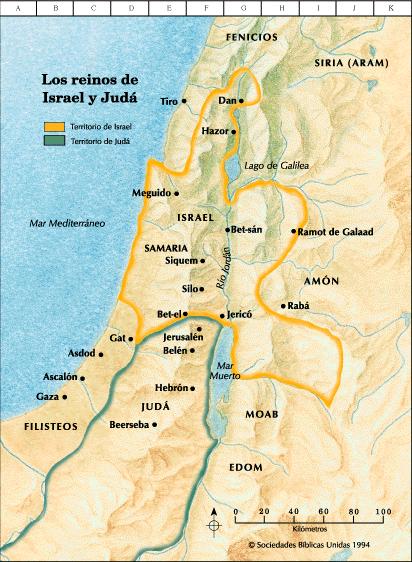
North Reich of Israel of the Omrids could have be like this
for a long time
The stele of king Mesha of Moab
in Dibon: Israel is dominating Moab - followed by a
reconquest step by step
According to this stele northern Reich of Israel has
occupied territories of Moab, and then king Mesha of Moab
performed a reconquest.

Map with Dibon, the capital of Moab, satellite photo
Here is the stele of Dibon found in 1868 in the ex capital
of Moab, with a long text in Moabite language (familiar to
biblical Hebrew). The text gives many details:
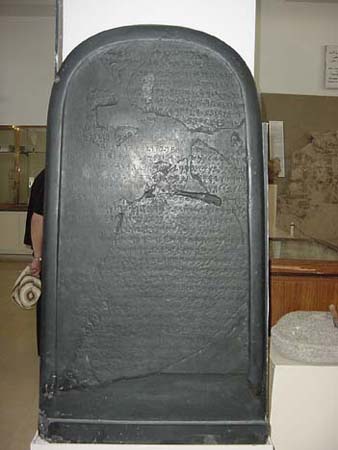
Victory stele of king Mesha, copy of the original
|
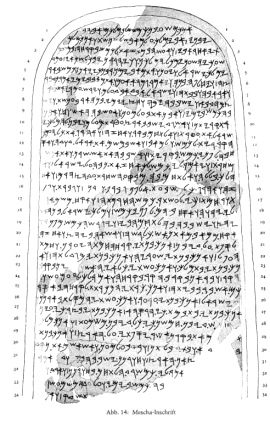
 Victory
stele of king Mesha, the text Victory
stele of king Mesha, the text
|
-- all in all the kingdom of Israel is said having had it's
borderlines up to far in the East and in the South
-- the stele describes the Omrids with the king Omri of
Israel who had "suppressed Moab many days"
"And Omri had occupied the land of Madeba. And he lived in
it. His days and the sum of the days of his sons are 40
years."
-- the successor of king Omri, king Ahab, "his son followed
him, and also he said: 'I will humiliate Moab' "
-- king Mesha of Moab succeeded with a reconquest of the
northern territory of Moab. Then he founded the capital of
Dibon where the stele was found (p.196)
-- the stele describes the achievements of king Mesha: the
reconquest is performed step by step with the destruction of
the Israeli capitals on the East Bank
-- at the same time king Mesha can fortify and beautify the
own capital (p.196).
According to the stele of Mesha king Mesha is mizprising the
Omrid dynasty (p.196).
The stele of Dan: there was an
Israeli attack on Assyria - and Hazael occupied parts of
Israel
The peaces of the stele of Dan (with the only indication of
a "house of David") are found in 1993 (p.193).
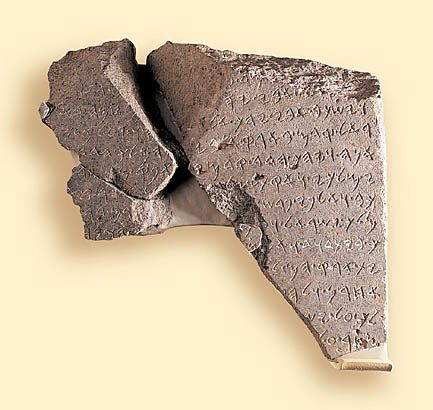
Peaces of the stele found in Dan in the hill of
ruins of Dan (tell Dan)
|
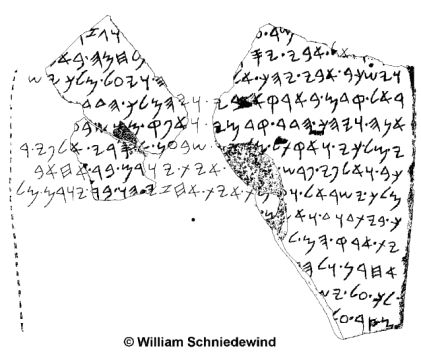
 The text of
the peaces of the stele of Dan found in Tell Dan,
completed by William Schniedewind The text of
the peaces of the stele of Dan found in Tell Dan,
completed by William Schniedewind
|
This stele could be from Aramean
king Hazael from Damascus. The text makes sense when king
Hazael of Aram Damascus is put in as the actor. So -
according to Finkelstein / Silberman - there had been the
following scenario (p.196):
-- the king of the northern Reich of
Israel is said having attacked Assyria passing Moab up to
the borderlines of Damascus:
"The king of I[s]rael before [before the
military campaign of Damascus against Israel] stepped on my
father's land." (p.197)
-- so, the northern Reich of Israel has
been a colonial power with an invason up to the borders of
Damascus (p.197)
-- the occupation of the town of Dan under
king Hazael follows only in about 835 B.C. [after the Omrid
dynasty] (p.196-197).
The death
of king Jehoram in the war against king Hazael - the
completed text of the stele
According to the
interpretation of the inscription of Tel Dan by Finkelstein
/ Silberman the death of king Jehoram is not caused by a
vineyard, but is provoked by an Aramean victory of Aram
Damascus with king Hazael [also Hasa'el], and also the son
of Jehoram, Ahaziah, was killed. The completed stele text in
a translation is like this:
"[I killed Je]horam,
the son of [Ahab], king of Israel, and [I] killed [Ahaz]ia,
the son of [Jehoram, kin]g of the house of David. And I made
[their towns to ruins and] gave their land [to be
destructed]." (p.221)
But there will never be a safe information,
if Jehu or the king of Aram Damascus, Hazael, was the murderer
(p.221).
Assyrian
sources: Monolith inscription from Assyrian Nimrud says the
invasion under Shalmaneser III was a draw
-- in 853 B.C. the
Assyrian king Shalmaneser III (858-824 B.C.) is looking for
a way to the coast and lets start a big army against the
little states of Aram Damascus,Phoenicia and Israel
-- at Karkar at Orontes river in western
Syria a battle with the anti Assyrian coalition is held with
the strongest parts of the war chariots from king Ahab from
Israel (p.197)
-- according to the monolith inscription
of Shalmaneser III [inscription in one single big stone]
king Ahab is one of the main enemies against the Assyrian
dominance in the Mid East (p.226)
-- Shalmaneser III describes himself as a
big winner against the big coalition
-- but the battle at
Karkar reduces the army of Shalmaneser that much so he is
not capable continuing his invasion but has to return to
Damascus (p.197).
There is never mentioned any South Reich
"Judah" (southern kingdom of Judah) or "Jerusalem" (p.198).
Finkelstein / Silberman mean that the
dynasty of the Omrids had the biggest professional army of
the region in this time, and that the policy of dominance of
the Omrid dynasty was on a relatively bad base, with
regional rivals and with a constant danger of Assyria
(p.198).
Later Assyrian sources name the northern
Reich of Israel even as "house of Omri", and this is an
indication that the new capital of Samaria really was
founded by the Omri family itself (p.198).






 Victory
stele of king Mesha, the text
Victory
stele of king Mesha, the text
